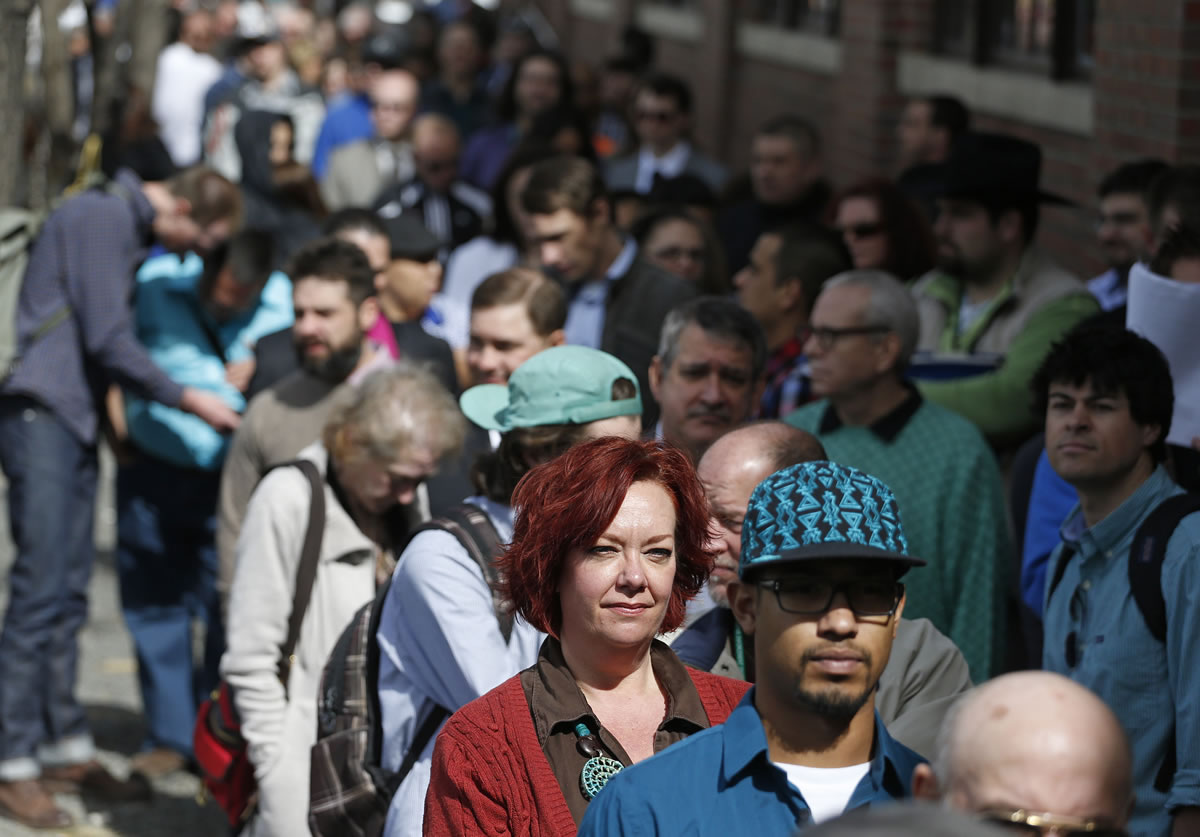WASHINGTON — The U.S. economy delivered a solid month of job growth in March and signaled that stronger gains could lie ahead: More Americans without jobs are starting to look for one, and paychecks are growing.
Yet Friday’s government report also showed how far the job market has to go: More than six years after the Great Recession began, private employment has only now regained its pre-recession level. Once you factor in population growth, hiring remains millions short of where it needs to be to reduce unemployment from a still-high 6.7 percent.
“We’re seeing sustained improvement,” said Scott Anderson, chief economist at Bank of the West. “But we’re not really that much stronger than we were last year. And we need more improvement for a stronger economy to come into fruition.”
U.S. employers added 192,000 jobs last month, just below February’s 197,000, which was revised higher. March’s figure nearly matched last year’s average monthly gain, suggesting that the economy has fully recovered from severe winter weather that slowed hiring in December and January.
Most economists expect job gains to pick up a bit in coming months, to a pace of 225,000 or more. One reason: Americans have reduced their debts and benefited from rising home prices and higher stock markets. Better household finances should translate into more spending.
And a major drag on growth — federal spending cuts and tax increases — will fade this year, likely boosting the economy. Budget battles and government shutdowns that have eroded business and consumer confidence since the recession ended are unlikely this year.
“Enough repair has happened in damaged sectors and there’s enough calm … so we can have a real recovery,” said Ethan Harris, global economist at Bank of America Merrill Lynch.
Greater business confidence has been good for companies such as Advanced Technology Services, a Peoria, Ill.-based firm that maintains machine tools, robotics, and computer systems for industrial companies such as Caterpillar, Honeywell and Honda.
The company has about 120 job openings for factory floor technicians, network engineers and information technology professionals. It has 2,700 employees in the United States and 300 more in Mexico and the United Kingdom.
Jeff Owens, president of ATS, said his clients appear more confident about economic growth and more willing to invest in machinery. He’s seeing solid growth in the automotive, food processing and oil and gas drilling equipment industries.
“The economy is better than it was a year or two ago,” Owens said. “We’re seeing that people are more comfortable with executing their strategic plans.”
The U.S. unemployment rate has been stuck at 6.7 percent since December, but that partly reflects a positive trend: More Americans, particularly younger people, are either working or looking for work.
So far this year, about 1.3 million people have started looking for jobs , and most have found them. Last year, by contrast, the number of people either working or looking for work had shrunk by roughly 500,000.
That’s a welcome change from the pattern that had prevailed since the recession: The proportion of Americans working or looking for work fell to a 35-year low in December. Many of the unemployed had become discouraged and stopped hunting for jobs.
In addition, many younger people stayed in school to avoid the job market. And some older Americans likely retired earlier than they would have otherwise.
For most of the past four years, the number of Americans who found jobs barely kept up with population growth. Now it’s growing slightly faster. As a result, the percentage of Americans age 16 or older who were working reached 58.9 percent in March — the highest point since 2009.
Another positive sign in the report: Americans worked more hours last month. The average work week rose to 34.5 hours last month, up from 34.3 in February.
More hiring plus a longer workweek means bigger paychecks for more Americans. That should help fuel more consumer spending and economic growth in the months ahead.
Still, for individual workers, average hourly pay slipped a penny to $24.30. Average hourly wages have risen 2.1 percent in the past year, faster than the 1.1 percent inflation rate. But in a healthy economy, hourly wages typically grow about 3.5 percent a year.
One thing holding back overall pay is the quality of jobs. Most of those added last month were in low-paying industries.
Temporary help agencies added 28,500 positions. Hotels and restaurants added 33,100, and retailers added 21,300.
Higher-paying positions didn’t fare as well. Manufacturers shed 1,000 jobs, the first such drop since July. And professional and technical services, which includes accountants, engineers and information technology workers, added just 10,400.
Freezing temperatures and heavy snowstorms this winter closed factories, slowed home sales and kept consumers away from shopping malls. As a result, many economists expect growth slowed to a 1.5 percent to 2 percent annual rate in the first three months of the year from 2.6 percent in the fourth quarter.
But steady hiring, greater business and consumer confidence and fewer government spending cuts should accelerate growth to about 3 percent for the rest of this year.



